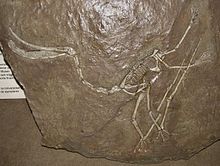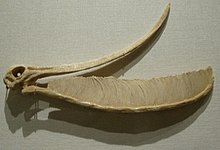Pterodaustro
| Pterodaustro | |
|---|---|

| |
| Cast of a fossil specimen at the Museo Argentino de Ciencias Naturales in Caballito, Buenos Aires, Argentina
| |
| Scientific classification | |
| Domain: | Eukaryota |
| Kingdom: | Animalia |
| Phylum: | Chordata |
| Order: | †Pterosauria |
| Suborder: | †Pterodactyloidea |
| Family: | †Ctenochasmatidae |
| Subfamily: | † Ctenochasmatinae
|
| Tribe: | † Pterodaustrini
|
| Genus: | †Pterodaustro Bonaparte, 1970 |
| Species: | †P. guinazui
|
| Binomial name | |
| †Pterodaustro guinazui Bonaparte, 1970
| |
| Synonyms | |
| |
Pterodaustro is a
Discovery and naming

The first fossils, among them the holotype PVL 2571, a thigh bone, were discovered during the late 1960s by José Bonaparte in the Lagarcito Formation, situated in the San Luis Province of Argentina, and dating from the Albian. The genus has later also been found in Chile in the Santa Ana Formation.[citation needed] At the Argentine site, the just 50 square meters (540 sq ft) large "Loma del Pterodaustro", since then, during several expeditions, over 750 Pterodaustro specimens have been collected, 288 of them having been catalogued until 2008. This makes the species one of the best known pterosaurs, with examples from all growth stages, from egg to adult.
The genus was named in 1969 by
Description

Pterodaustro has a very elongated skull, up to 29 centimeters (11 in) long. The portion in front of the eye sockets comprises 85 percent of skull length. The long snout and lower jaws curve strongly upwards; the
The back of the skull was also rather elongated and in a low position; there are some indications for a low parietal crest.
Pterodaustro had a maximum adult wingspan of approximately 3 m (9.8 ft) and a maximum body mass of approximately 9.2 kg (20 lb).[5] Its hindlimbs are rather robust and its feet large. Its tail is uniquely elongated for a pterodactyloid, containing twenty-two caudal vertebrae, whereas other members of this group have at most, sixteen.
Paleobiology

Pterodaustro probably strained food with its tooth comb, a method called "filter feeding", also practised by modern
At least two specimens of Pterodaustro have been found, MIC V263 and MIC V243, with
A study of the growth stages of Pterodaustro concluded that juveniles grew relatively fast in their first two years, attaining about half of the adult size. Then they reached sexual maturity, growing at a slower rate for four to five years until there was a determinate growth stop.[10]
In 2004 a Pterodaustro embryo in an egg was reported, specimen MHIN-UNSL-GEO-V246. The egg was elongated, 6 centimeters (2.4 in) long and 22 millimeters (0.87 in) across, and its mainly flexible shell was covered with a thin layer of calcite, 0.3 millimeters thick.[11] Three-dimensionally preserved eggs were reported in 2014.[12]
Comparisons between the
Because of its long torso and neck and comparatively short legs, Pterodaustro was unique among pterosaurs in having difficulties to launch. Even with the pterosaurian quadrupedal launching mechanism, it would have required frantic and fairly-low angled take-offs possible only in open areas, much like modern
Phylogeny
Bonaparte in 1970 assigned Pterodaustro to the

In 2018, a topology by Longrich, Martill and Andres recovered Pterodaustro within the family
| Ctenochasmatidae |
| ||||||||||||||||||||||||||||||||||||||||||
See also
References
- ^ L. Codorniú and Z. Gasparini. 2007. Pterosauria. In Z. Gasparini, L. Salgado, R. A. Coria (eds.), Patagonian Mesozoic Reptiles. Indiana University Press, Bloomington, IN 143-166.
- ^ Bonaparte, J. F. (1970). "Pterodaustro guinazui gen. et sp. nov. Pterosaurio de la Formacion Lagarcito, Provincia de San Luis, Argentina y su significado en la geologia regional (Pterodactylidae)". Acta Geologica Lilloana. 10: 209–225.
- ISBN 0-7607-0154-7.
- PMID 10562511.
- PMID 34294737.
- ISBN 1-84028-152-9.
- ^ ISBN 0691150613.
- ISBN 978-0-7525-3166-3.[page needed]
- ^ Codorniú, L., Chiappe, L.M., Arcucci, A., and Ortiz-Suarez, A. (2009). "First occurrence of gastroliths in Pterosauria (Early Cretaceous, Argentina)". XXIV Jornadas Argentinas de Paleontología de Vertebrados
- PMID 18308672.)
{{cite journal}}: CS1 maint: multiple names: authors list (link - S2CID 4396534.)
{{cite journal}}: CS1 maint: multiple names: authors list (link - hdl:11336/6990.
- S2CID 33253407.
- ISSN 0036-8075.
- ^ Longrich, N.R., Martill, D.M., and Andres, B. (2018). Late Maastrichtian pterosaurs from North Africa and mass extinction of Pterosauria at the Cretaceous-Paleogene boundary. PLoS Biology, 16(3): e2001663.
